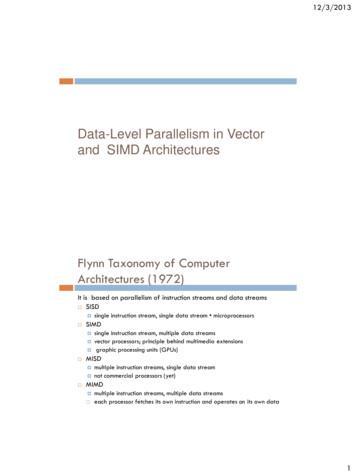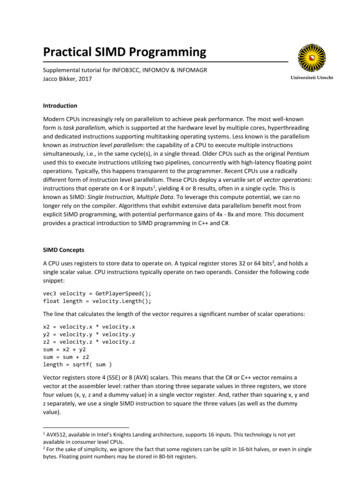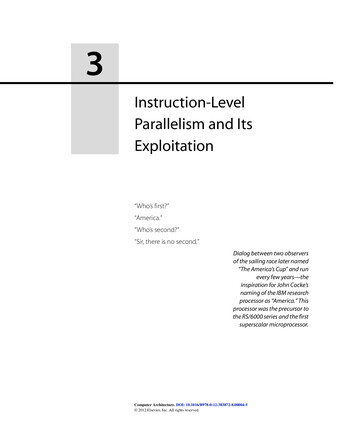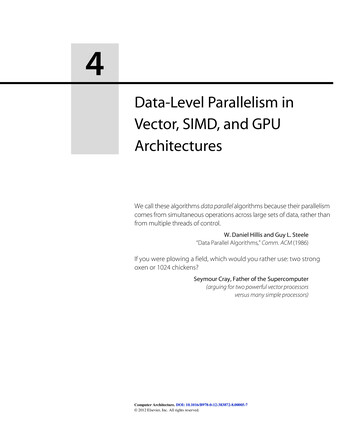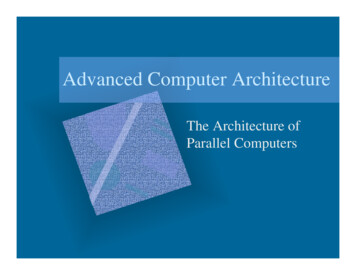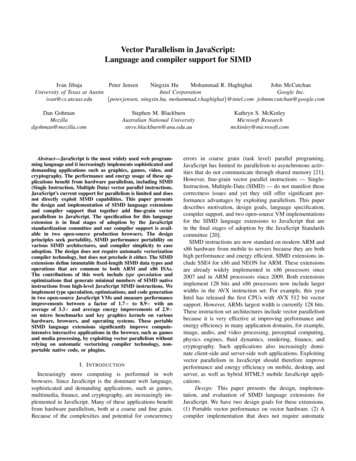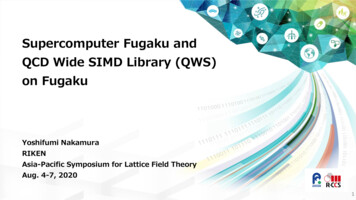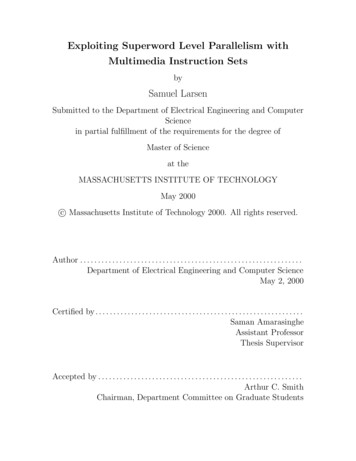
Transcription
Use of SIMD-Based Data Parallelism to Speed upSieving in Integer-Factoring Algorithms ?Binanda Sengupta and Abhijit DasDepartment of Computer Science and EngineeringIndian Institute of Technology Kharagpur, West Bengal, PIN: 721302, tract. Many cryptographic protocols derive their security from the apparent computational intractability of the integer factorization problem. Currently,the best known integer-factoring algorithms run in subexponential time. Efficient parallel implementations of these algorithms constitute an important areaof practical research. Most reported implementations use multi-core and/or distributed parallelization. In this paper, we use SIMD-based parallelization to speedup the sieving stage of integer-factoring algorithms. We experiment on the twofastest variants of factoring algorithms: the number-field sieve method and themultiple-polynomial quadratic sieve method. Using Intel’s SSE2 and AVX intrinsics, we have been able to speed up index calculations in each core duringsieving. This performance enhancement is attributed to a reduction in the packing and unpacking overheads associated with SIMD registers. We handle bothline sieving and lattice sieving. We also propose improvements to make our implementations cache-friendly. We obtain speedup figures in the range 5–40%. Tothe best of our knowledge, no public discussions on SIMD parallelization in thecontext of integer-factoring algorithms are available in the literature.Keywords: Integer Factorization, Sieving, Multiple-Polynomial Quadratic SieveMethod, Number-Field Sieve Method, Single Instruction Multiple Data, Streaming SIMD Extensions, Advanced Vector Extensions1IntroductionLet n be a large composite integer having the factorizationvpvpvpkvpn p1 1 p2 2 · · · pk k pi i .i 1The integer factorization problem deals with the determination of all the prime divisorsp1 , p2 , . . . , pk of n and their corresponding multiplicities v p1 , v p2 , . . . , v pk . The earlier algorithms proposed to solve this problem run in exponential time in the input size (thenumber of bits in n, that is, log2 n or lg n). Modern factoring algorithms have subexponential running times of the form L(n, ω, c) exp (c o(1))(ln n)ω (ln ln n)1 ω ,?A version of this paper appears in the journal Applied Mathematics and 8.019).
where c and ω are positive real constants with 0 ω 1. The smaller the constants ωand c are, the faster these algorithms are. The fastest known general-purpose factoringalgorithm is the (general) number-field sieve method (NFSM) for which ω 1/3 andc (64/9)1/3 1.923. The multiple-polynomial quadratic sieve method (MPQSM)is reported as the second fastest factoring algorithm. Its running time corresponds toω 1/2. Although the NFSM is theoretically faster than the MPQSM, the asymptoticbehavior shows up only when the input integer n is moderately large (having at leasta few hundred bits). Better than fully exponential-time algorithms as they are, thesesubexponential algorithms are still prohibitively slow, and it is infeasible to factor a1024-bit composite integer in a reasonable amount of time (like a few years). Manycryptographic protocols (including RSA) derive their security from this apparent intractability of the integer-factoring problem.The most time-consuming part in the NFSM and the MPQSM is the sieving stagein which a large number of candidates (suitably small positive or negative integers) aregenerated. Only those candidates which factor completely over a predetermined set ofsmall primes yield useful relations. We combine these relations using linear-algebratools in order to arrive at a congruence of the form x2 y2 (mod n). If x 6 y (mod n),the nontrivial factor gcd(x y, n) is discovered.In this paper, we deal with efficient implementations of the sieving stage in theNFSM and the MPQSM. Sieving turns out to be massively parallelizable on multi-coreand even distributed platforms. All recent implementations of sieving in the literaturedeal with issues of such large-scale parallelization. In this paper, we look at the problemfrom a different angle. We plan to exploit SIMD features commonly available in moderndesktop and server machines. We investigate whether SIMD-based parallelization canlead to some speedup in the computation of each core. The sieving procedure involvestwo data-parallel operations: computation of indices and subtraction of log values. Wetheoretically and experimentally demonstrate that the index-calculation process can beeffectively parallelized by SIMD intrinsics. This effectiveness banks on that we canavoid packing of data in SIMD registers in each iteration of the sieving loop. The subtraction operations, on the other hand, do not benefit from such parallelization efforts.First, we need packing and unpacking of SIMD registers in each iteration of the loop.Second, the individual data items that are packed in SIMD registers do not belong tocontiguous locations in the memory.The main technical contribution of this paper is the successful parallelization of index calculations in the sieving stage using Intel’s SSE2 (Streaming SIMD Extensions)and AVX (Advanced Vector Extensions) features on a Sandy Bridge platform. We havebeen able to speed up the sieving stage of both the NFSM and the MPQSM by 5–40%.Intel’s recently released AVX2 instruction set is expected to increase this speedup further (AVX uses 256-bit vectorization only on floating-point values, whereas AVX2 hasthis feature for integer operands too). We study two variants of sieving—the line sieveand the lattice sieve—in the NFSM implementation. We also propose a cache-friendlyimplementation strategy. To the best of our knowledge, no SIMD-based parallelizationattempts on sieving algorithms for integer factorization are reported in the literature.The implementations described by [1] and [2] use the term SIMD but are akin to multicore parallelization in a 16K MasPar SIMD machine with a 128 128 array of pro-
cessing elements. In this paper, we show that the use of SSE2 and AVX instruction setsavailable in modern processors can achieve an additional speedup on each these cores.The rest of the paper is organized as follows. Section 2 introduces the backgroundrelevant for the remaining sections, namely, the sieving procedures in the MPQSM andin the NFSM, the lattice sieve, and Intel’s SSE2 and AVX components. In Section 3,we detail our implementation strategies for the MPQSM and the NFSM sieves. Section4 presents our experimental results achieved on a Sandy Bridge platform. We analyzethe speedup figures, and demonstrate the effectiveness of our cache-friendly implementation. We conclude the paper in Section 5 after highlighting some possible futureextensions of our work.22.1BackgroundA Summary of Known Integer-Factoring AlgorithmsMost modern integer-factoring algorithms construct Fermat congruences of the formx2 y2 (mod n). If x 6 y (mod n), then gcd(x y, n) is a non-trivial factor of n. If thesecongruences are available for many random values of x and y, at least some of thesepairs is/are expected to reveal non-trivial factors of n with high probability. In orderto generate such congruences, one collects many relations, each of which supplies alinear equation modulo 2. Relation collection is efficiently carried out by sieving. Aftersufficiently many relations are collected, the linear equations are combined to find nonzero vectors in the nullspace of the system. Each such non-zero vector yields a Fermatcongruence. The factoring algorithms differ from one another in the way the relationsare generated, that is, in their sieving techniques. The linear-algebra phase turns out tobe identical in all these algorithms.J. D. Dixon [3] proposes the simplest variant of such a factoring method. Based onthe work of Lehmer and Powers [4], Morrison and Brillhart introduce another variantknown as the CFRAC method [5], where relations are obtained from the continuedfraction expansion of n.In Pomerance’s quadraticsieve method (QSM) [6], the polynomial T (c) J 2Hc c2 (where H d n e and J H 2 n) is evaluated for small values of c (inthe range M 6 c 6 M). If some T (c) value factors completely over the first t primesp1 , p2 , . . . , pt , we get a relation. In Dixon’s method, the smoothness candidates are O(n),whereas in CFRAC and QSM, these are O( n), resulting in a larger proportion ofsmooth integers (than Dixon’s method) in the pool of smoothness candidates. Moreover, QSM replaces trial divisions by sieving (subtractions after some preprocessing).This gives QSM a better running time than Dixon’s method and CFRAC.R. D. Silverman introduces a variant of quadratic sieve method, called the multiplepolynomial quadratic sieve method (MPQSM) [7]. Instead of using the fixed polynomial T (c), the MPQSM uses a more general polynomial T (c) W c2 2V c U so thatthe smoothness candidates are somewhat smaller than those in the QSM.The number field sieve method (NFSM) is originally proposed for integers of aspecial form [8], and is later extended to factor arbitrary integers [9]. Pollard introducesthe concept of lattice sieving [10] as an efficient implementation of the sieves in theNFSM. The conventional sieving is called line sieving.
Some other methods for factoring large integers include the cubic sieve method(CSM) [11] and the elliptic curve method (ECM) [12].The linear-algebra phase in factoring algorithms can be reasonably efficiently solvedusing sparse system solvers like the block Lanczos method [13]. We do not deal withthis phase in this paper. We focus our attention only to the relation-collection stage(more precisely, the sieving part of it).2.2A Brief Introduction to SIMD FeaturesAll our implementations of sieving use SIMD (Single Instruction Multiple Data) parallelization. We carry out our experiments on a Sandy Bridge architecture from Intel.This architecture provides two types of vectorization primitives SSE2 and AVX.SSE (Streaming SIMD Extensions) [14] is an extension of the previous x86 instruction set, and SSE2 enhances the SSE instruction set further. SSE2 instructions apply to128-bit SIMD registers (XMM). In each XMM register, we can accommodate multipledata of some basic types (like four 32-bit integers, four single-precision floating-pointnumbers, and two double-precision floating-point numbers). There are special instructions to perform vector operations (like arithmetic, logical, shift, conversion, and comparison) on these XMM registers. The basic idea to exploit this architecture is to packthese registers with multiple data, perform a single vector instruction, and finally unpack the output XMM register to obtain the desired individual results.AVX (Advanced Vector Extensions) [15] is a recent extension to the general x86instruction set. It is introduced in Intel’s Sandy Bridge processor. This architecture isdesigned with sixteen 256-bit SIMD registers (YMM). Now, we can accommodate eightsingle-precision or four double-precision floating-point numbers in one YMM register.AVX is designed with three-operand non-destructive SIMD instructions, where the destination register is different from the two source registers.Another important point to note here is that mixing of AVX instructions and legacy(that is, non-VEX-encoded) SSE instructions is not recommended. XMM registers arealiased as the lower 128 bits of YMM registers. Every AVX-SSE or SSE-AVX transition incurs severe clock-cycle penalties. To eliminate AVX-SSE transitions, legacy SSEinstructions can be converted to their equivalent VEX-encoded instructions by zeroingthe upper 128 bits of the YMM registers, as suggested in [16].The AVX instruction set is currently applicable for only floating-point operations.Intel’s Haswell architecture incorporates another extension AVX2 which supports instructions for integer operations on 256-bit registers. Programming languages comewith intrinsics for high-level access to SIMD instructions. We can use these intrinsicsdirectly in our implementations to exploit data parallelism.2.3The MPQSM SieveThe MPQSM is a variant of the quadratic sieve method (QSM). Instead of using a single polynomial (with fixed coefficients), the MPQSM deals with a general polynomialand tunes its coefficients to generate small smoothness candidates. This variant is parallelizable in the sense that different polynomials can be assigned to different cores.
The MPQSM sieve deals with a polynomialT (c) W c2 2V c U(1)with V 2 UW n. The factor base consists of the first t primes p1 , p2 , . . . , pt , wheret is chosen based on a bound B. Only those primes are included in the factor base,modulo which n is a quadratic residue. First, we calculate the values of T (c) for all cin the range M 6 c 6 M. Now, we try to find those values of c, for which T (c) isB-smooth, that is, T (c) factors completely into primes 6 B. If T (c) pα1 1 pα2 2 · · · ptαt forsome non-negative integral values of αi , then by multiplying Eqn (1) by W we get therelation(2)(W c V )2 W pα1 1 pα2 2 · · · ptαt (mod n).We include W too in the factor base.Now, we briefly discuss the sieving step in the MPQSM. The smoothness candidatesare the values T (c) of Eqn (1) for all c in the range [ M, M]. We need to locate thosevalues of c for which T (c) is smooth over the factor base. We take an array A indexedby c. Initially, we store log T (c) in A[c], truncated after three decimal places. Indeed,we can avoid floating-point operations by storing b1000 log T (c) c.After this initialization, we try to find solutions of the congruence T (c) 0 (mod ph ),where p is a small prime in the factor base, and h is a small positive exponent. The solutions of the congruenceW c2 2V c U 0 (mod ph ),are 2V 4V 2 4UW V nc W 1 ( V n) (mod ph ).(3)2WWFor h 1, we use a root-finding algorithm to compute the square roots of n modulop (see [17, 18]). For h 1, we obtain the solutions modulo ph by lifting the solutionsmodulo ph 1 (see [19]).Let s1 , s2 be the solutions of T (c) 0 (mod ph ) chosen to be as small as possiblein the range [ M, M]. Then, all the solutions of T (c) 0 (mod ph ) are s1 j ph ands2 j ph for j 0, 1, 2, 3, . . . . We subtract b1000 log pc from these array locations. Forp 2 and h 1, there is only one initial solution of the congruence. For p 2 andh 1, there may be more than two initial solutions.When all appropriate values of ph are considered, the array locations storing A[c] 0 correspond to the smooth values of T (c). We apply trial division on these smoothvalues of T (c). If some T (c) value is not smooth, then the corresponding array entryA[c] holds an integer b1000 log pt 1 c for the smallest prime pt 1 B. This justifiesthe correctness of the calculations using approximate (truncated) log values.2.4The NFSM SieveThe NFSM [9] involves a monic irreducible polynomial f (x) Z[x] of a small degree dand an integer m n1/d such that f (m) 0 (mod n), n being the integer to be factored.One possibility is to take m bn1/d c, and express n in base m as n md cd 1 md 1
· · · c0 , with the integers ci varying in the range 0 to m 1. For this choice, we takef (x) xd cd 1 xd 1 · · · c0 , provided that it is an irreducible polynomial in Z[x].We have f (m) n, implying that f (m) 0 (mod n), as desired.If θ C is a root of a monic irreducible polynomial f (x) of degree d with integralcoefficients and m Z is an integer such that f (m) 0 (mod n), then there exists a ringhomomorphism φ : Z[θ ] Zn defined by φ (θ ) m (mod n) (and φ (1) 1 (mod n)).1Now, let E be a set of pairs of integers (a, b) satisfying(a bθ ) α 2 , (a,b) E (a bm) y2 ,(a,b) Efor some α Z[θ ] and y Z. Let φ (α) x Zn . Then, we get the Fermat congruencex2 φ (α)2 φ (α 2 ) φ ((a bθ )) (a,b) E (a,b) Eφ (a bθ ) (a bm) y2 (mod n).(a,b) EThe NFSM uses a rational factor base (RFB) and an algebraic factor base (AFB).The RFB consists of the first t1 primes p1 , p2 , . . . , pt1 , where t1 is chosen based on abound Brat . The AFB consists of some primes of small norms in O. Application ofthe homomorphism φ lets us rewrite the AFB in terms of t2 rational (integer) primesp1 , p2 , . . . , pt2 , where t2 is chosen based on a bound Balg .Now, we describe the rational sieve and the algebraic sieve of the NFSM. Here, wedeal with incomplete sieving (see [19]), that is, higher powers of factor-base primes arenot considered in sieving.Let T (a, b) a bm. First, we calculate the values of T (a, b) for all b in the range1 6 b 6 u and a in the range u 6 a 6 u. Now, we try to find those (a, b) pairs withgcd(a, b) 1 and b 6 0 (mod p), for which T (a, b) is Brat -smooth, that is, T (a, b) factors completely into the primes p1 , p2 , . . . , pt1 . The determination whether a small primepi divides some a bm is equivalent to solving the congruence a bm 0 (mod pi ).The sieving bound u is determined based upon certain formulas which probabilisticallyguarantee that we can obtain the requisite number of relations from the entire sievingprocess.We take a two-dimensional array A indexed by a and b. Initially, we store log T (a, b) in A[a, b], truncated after three decimal places (or the integers b1000 log T (a, b) c). After this initialization, we find solutions of the congruence T (a, b) 0 (mod p), where pis a small prime in the RFB. For a fixed b, the solutions are a bm (mod p). Let s bethe least possible solution of T (a, b) 0 (mod p) in the range [ u, u] for a particular b.Then, all the solutions of T (a, b) 0 (mod p) for that b are s j p, j 0, 1, 2, 3, . . . . We1Cdenotes the field of complex numbers, and Q the field of rational numbers. For an algebraicelement θ C, Q(θ ) stands for the field obtained by adjoining θ to Q. O is the set of allalgebraic integers in Q(θ ). Z[θ ], a subring of O, is the set of all Z-linear combinations of theelements 1, θ , θ 2 , . . . , θ d 1 .
subtract b1000 log pc from all the array locations A[a, b] such that a s j p. We repeatthis procedure for all small primes p in the RFB and for all allowed values of b. Aswe deal with only small primes with exponent h 1, the array locations storing A[a, b]values less than b1000ξ log pt1 1 c (where pt1 1 is the smallest prime greater than Brat ,and ξ lies between 1.0 and 2.5) are subjected to trial division to verify the smoothnessof T (a, b).The algebraic sieve uses the norm function N : Q(θ ) Q. Its restriction to Z[θ ]yields norm values in Z. For an element of the form a bθ Z[θ ], we have the explicitformula:N(a bθ ) ( b)d f ( a/b) ad cd 1 ad 1 b · · · ( 1)d c0 bd ,where f (x) xd cd 1 xd 1 · · · c0 .An element α Z[θ ] is smooth with respect to the small primes of O if and onlyif N(α) Z is Balg -smooth. For each small prime p in the AFB, we compute the set ofzeros of f modulo p, that is, all r values satisfying the congruence f (r) 0 (mod p).For a particular b with b 6 0 (mod p) and 1 6 b 6 u, the norm values with N(a bθ ) 0 (mod p) correspond to the a values given by a br (mod p) for some root r of fmodulo p. It follows that the same sieving technique as discussed for the rational sievecan be easily adapted to the case of the algebraic sieve.An (a, b) pair for which both a bm and a bθ are smooth gives us a relation.Sufficiently many relations obtained from the two sieves are combined using linearalgebra to get the set E of (a, b) pairs such that (a bm) y2 and (a (a,b) E(a,b) Ebθ ) α 2 .2.5The Lattice Sieve MethodPollard [10] introduces the lattice sieve method based on an idea proposed in [20]. Here,we describe the lattice sieve (its sieving-by-rows variant) for the rational sieve only. Thesame technique can be used in the algebraic sieve too. First, we take the rational factorbase Brat , and partition Brat in the following way. By S, we denote the set consisting ofall small primes p of the factor base with p 6 B0rat . Moreover, we denote by M the setconsisting of all medium primes q of the factor base with B0rat q 6 Brat . Usually, B0ratis selected in such a way that the ratio B0rat /Brat lies between 0.1 and 0.5.Let q M be a medium prime (also called a special q in the notation of [20]).Unlike the line sieve described in earlier chapters, we now take into account a regionR in the (a, b) plane. For a particular q, we sieve only those (a, b) pairs which satisfythe congruence a bm 0 (mod q). Furthermore, we consider only the small primes pwith p q while sieving the integers a bm for a fixed q.All the pairs (a, b) satisfying a bm 0 (mod q) form a lattice Lq in the (a, b) plane.The vectors w1 (q, 0) and w2 ( m, 1) generate the lattice Lq . This basis is reducedusing Lagrange’s lattice-basis reduction algorithm for two-dimensional lattices (see [21,22]). The algorithm is similar to Euclid’s gcd computation and is given as Algorithm 1.The iterations of the while loop monotonically decrease the Euclidean norms of v1 andv2 by subtracting an appropriate multiple of the shorter vector from the other.
Algorithm 1 : Lagrange’s rank-2 lattice-basis reduction algorithmInput : A basis {w1 , w2 } of a two-dimensional lattice LOutput: A Lagrange-reduced basis {v1 , v2 } of Lv1 w1 and v2 w2. Initializationif ( v1 v2 ) then. v denotes Euclidean norm of vector vswap(v1 , v2 )end ifwhile ( v1 v2 ) dou (v1 · v2 )/(v1 · v1 ). uv1 is the orthogonal projection of v2 on v1. Here, · denotes the inner or dot product of two vectorsv2 v2 round(u)v1swap(v1 , v2 )end whileswap(v1 , v2 ). To ensure v1 6 v2 Return (v1 , v2 )From Algorithm 1, we get a reduced basis {v1 , v2 } of the lattice Lq with v1 beingthe shorter one. Let us write v1 (a1 , b1 ) and v2 (a2 , b2 ). All the points of Lq canbe uniquely represented as l1 v1 l2 v2 for l1 , l2 Z. The lattice sieving takes place inthe (l1 , l2 ) plane. Given a pair (l1 , l2 ), we can retrieve the corresponding (a, b) pair as(a, b) (l1 a1 l2 a2 , l1 b1 l2 b2 ).We take two sieving bounds L1 and L2 and a two-dimensional array A indexed byl1 and l2 . The indices vary in the ranges L1 6 l1 6 L1 and 1 6 l2 6 L2 . The arraylocation (l1 , l2 ) represents the value a bm l1 u1 l2 u2 , where u1 a1 b1 m andu2 a2 b2 m with gcd(u1 , u2 ) q. As v1 is shorter than v2 , we choose L1 L2 in orderto make sieving efficient. All the array elements are initialized to zero. Subsequently,b1000 log pc values are added to A[l1 , l2 ] for all primes p q for which l1 u1 l2 u2 0 (mod p). After all primes p are considered, the sum stored in A[l1 , l2 ] is subtractedfrom b1000 log(a bm)c for the corresponding (a, b) pair. If the difference is smallerthan a threshold, trial division is used to verify whether a bm is actually smooth.The threshold is usually chosen to be b1000ξ log pt1 1 c for the smallest prime pt1 1 Brat and with 1.0 6 ξ 6 2.5. This liberal selection is necessitated by the fact that thecongruence a bm 0 (mod ph ) is now solved only for h 1.The above steps are repeated for each medium prime q M.3Implementation DetailsCurrently, the largest general-purpose integer that has been factored by a subexponential algorithm is a 768-bit (232-digit) RSA modulus (see [23]). Consequently, we restrictour experiments to integers with no more than 250 decimal digits. For the NFSM, weexperiment with two integers n1 and n2 having 60 and 120 decimal digits, respectively.Each of these is like an RSA modulus (that is, a product of two primes of the same bitlength). In the MPQSM, we have implemented the complete sieve, that is, the congruence T (c) 0 (mod ph ) is solved for all relevant p, h values. For the NFSM, on theother hand, we have implemented only the incomplete sieve, that is, the value h 1 is
only considered. We have not gone for any sophisticated polynomial-selection procedure in the NFSM. We have instead chosen f (x) to be the polynomial obtained fromthe m-ary representation of n, where m n1/d . As suggested in [2, 24], we take d 3if the number of digits in n is less than 80, and d 5 for larger integers.3.1Sequential ImplementationsThe sequential implementations are straightforward. Let us consider the MPQSM sievefirst. For a small prime p in the factor base, let H be the largest exponent h for whichEqn (3) is satisfied by some c [ M, M]. For each h {1, 2, . . . , H}, these solutionsare precomputed before the sieving loop. Let s be a solution for some p, h values. Wetake s to be the minimum location in the sieving interval [ M, M]. We sieve the arrayA by subtracting b1000 log pc from all the array locations c s j ph with j N. Thisprocedure is repeated for all small primes in the factor base. Algorithm 2 presents apseudocode of our sequential implementation of the MPQSM sieve.Algorithm 2 Pseudocode for the sequential implementation of the MPQSM sieveInput : Factor base FB, sieving bound M, and sieving array A indexed by cOutput: Sieving array A after subtractions of log valuesfor all c in the range M 6 c 6 M doA[c] b1000 log T (c)cend forfor all prime powers ph do. Prime p FB and h small positive integerLet s be a solution of of T (c) 0 (mod ph ). These solutions are precomputedfor all solutions s doc the smallest solution congruent to s (mod ph ) in the range [ M, M]while c 6 M do. Sieving loopA[c] A[c] b1000 log pc. b1000 log pc are globally constant valuesc c ph. The next solutionend whileend forend forIn the NFSM, the rational and the algebraic sieves are carried out independently intwo two-dimensional arrays. If for some pair (a, b) with gcd(a, b) 1, both a bm anda bθ are found to be smooth from the two sieves, we obtain a relation. The numberof relations depends on the sieving bound u. Our basic goal is to investigate the benefitsof SIMD parallelization instead of generating a complete solvable system, so we haveexperimented with small sieving bounds only.In the lattice sieve method, we choose a medium prime q M. Then, we determinea reduced basis {v1 , v2 } for Lq using Algorithm 1 (see Section 2.5). Subsequently, therational sieve is carried out in a two-dimensional array whose rows and columns are indexed by l2 and l1 , respectively. We consider sieving by rows only, that is, we fix l2 , startwith the least array location l1 in the sieving interval satisfying l1 u1 l2 u2 0 (mod p),
Fig. 1. SIMD-based index calculations during sievings1 ph11s1 ph11 s1 ph11ph11s1 2ph11h2h2h2h2s2 p2s2 p2s2 p2p2s2 2ph22s3 ph33s3 ph33 s3 ph33ph33s3 2ph33, . , ··· . . .skphk ksk phk k sk phk kphk ksk 2phk kand sieve all the other locations for the particular row l2 . We precompute u 11 (mod p)to find the initial solutions for different l2 values. If u1 0 (mod p) or u2 0 (mod p),we sieve all elements of every p-th row or every p-th column, respectively. We consideronly the coprime (l1 , l2 ) pairs. Finally, the gcd of every pair (a, b) indicating smoothness is calculated. If this gcd is one, the (a, b) pair provides a relation. If gcd(a, b) q,we take the pair (a/q, b/q) into account. If the value of b turns out to be negative, wechange the signs of both a and b.3.2Parallel Index CalculationsThe procedure for data-parallel index calculations is shown in Figure 1. An SIMDregister is packed with k 32-bit integer or single-precision floating-point values. TheSIMD registers are of sizes 128 and 256 bits in SSE2 and AVX, respectively. So wehave k 4 or 8. Parallel index calculations proceed in the following way. We packan SIMD register with the values s1 , s2 , . . . , sk and another SIMD register with the valhues ph11 , ph22 , . . . , pk k , where s1 , s2 , . . . , sk are the solutions of the congruence T (c) 0hh1 h2modulo p1 , p2 , . . . , pk k , respectively. These initial solutions are taken to be as small aspossible in the sieving range. Then, k parallel additions take place with the help of asingle SIMD addition instruction. The individual indices are obtained by extracting thecomponents of the SIMD register storing the sum. However, a repacking of these indicesis not needed in the next iteration. The output SIMD register of one iteration is directlyfed as an input in the next iteration. In all these index calculations, the second SIMDregister (holding the ph values) remains constant. The parallel index-calculation loopterminates when the value of any of the k components goes beyond the sieving range.The smoothness candidates in the NFSM are polynomial expressions in two variablesa, b. If we fix b and vary a, sieving becomes identical to the univariate case of T (c). Acouple of general points concerning these data-parallel implementations are in order.In both the SSE2 and AVX implementations, we use 32-bit chunks (integers orfloating-point numbers) to populate SIMD registers. This means that a single vectoraddition in SSE2 computes four sums in parallel. For AVX, eight sums are carried outby each such vector addition. Both SSE2 and AVX support packing of 64-bit units(double-precision integers or floating-point numbers). But this reduces the extent ofparallelism. Moreover, so long as array indices are restricted to single-precision values(as is usually the case), use of 64-bit units not only is wasteful of space but also increasesthe relative overhead associated with packing and unpacking.
AVX provides 256-bit vector operations on floating-point numbers only. Therefore,we transform 32-bit integers to 32-bit single-precision floating-point numbers and packthese floating-point numbers in an SIMD register. After a vector addition, the floatingpoint units are converted back to integers after unpacking. This, however, comes at acost. First, this introduces overheads associated with convers
context of integer-factoring algorithms are available in the literature. Keywords: Integer Factorization, Sieving, Multiple-Polynomial Quadratic Sieve Method, Number-Field Sieve Method, Single Instruction Multiple Data, Stream-ing SIMD Extensions, Advanced Vector Extensions 1 Introduction Let n be a large composite integer having the .
